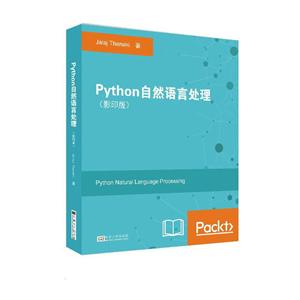掃一掃
關(guān)注中圖網(wǎng)
官方微博
包郵 Python自然語言處理
開本:
24cm
頁數(shù):
10,464頁
本類五星書更多>
-
>
全國計(jì)算機(jī)等級考試最新真考題庫模擬考場及詳解·二級MSOffice高級應(yīng)用
-
>
決戰(zhàn)行測5000題(言語理解與表達(dá))
-
>
軟件性能測試.分析與調(diào)優(yōu)實(shí)踐之路
-
>
第一行代碼Android
-
>
JAVA持續(xù)交付
-
>
EXCEL最強(qiáng)教科書(完全版)(全彩印刷)
-
>
深度學(xué)習(xí)
Python自然語言處理 版權(quán)信息
- ISBN:9787564178659
- 條形碼:9787564178659 ; 978-7-5641-7865-9
- 裝幀:一般輕型紙
- 冊數(shù):暫無
- 重量:暫無
- 所屬分類:>
Python自然語言處理 內(nèi)容簡介
解釋了為什么Python是構(gòu)建基于NLP的專家系統(tǒng)的佳選之一。通過本書你將知道如何為自然語言處理應(yīng)用程序選擇數(shù)據(jù)集,并找到正確的NLP技術(shù)來處理數(shù)據(jù)集中的句子并理解它們的結(jié)構(gòu)。你還將學(xué)習(xí)如何標(biāo)記句子的不同部分以及分析它們的方法。你將探索文本的語義和句法分析,還將了解如何處理人類語言中的各種歧義,并在各種場景中執(zhí)行文本分析。
Python自然語言處理 目錄
Preface
Chapter 1:Introduction
Understanding natural language processing
Understanding basic applications
Understanding advanced applications
Advantages of togetherness—N LP and Python
Environment setup for NLTK
Tips for readers
Summary
Chapter 2:Practical Understanding of a Corpus and Datase
What is a corpus
Why do we need a corpus
UnderStanding corpus analysis
Exercise
Understanding types of data attributes
Categorical or qualitative data attributes
Numeric or quantitative data attributes
Exploring different file formats for corpora
Resources for accessing free corpora
Preparing a dataset for NLP applications
Selecting data
Preprocessing the dataset
Formatting
Cleaning
Sampling
Transforming data
Web scraping
Summary
Chapter 3:Understanding the Structure of a Sentences
Understanding components of NLP
Natural language understanding
Natural language generation
Differences between NLU and NLG
Branches nf NLP
Defining context-free grammar
Exercise
Morphological analysis
What is morphology
What are morphemes
What is a stem
What is morphological analysis
What iS a word
Classification of morphemes
Free morphemes
Bound morphemes
Derivational morphemes
Inflectional morphemes
What is the difference between a stem and a root
Exercise
Lexical analysis
Whal is a token
What are part of speech tags
Process of deriving tokens
Difference between stemming and lemmatization
Applications
Syntactic analysis
What is syntactic analysis
Semantic analysis
What is semantic analysis
Lexical semantics
Hyponymy and hyponyms
Homonymy
Polysemy
What is the difference between polysemy and homonymy
Application of semantic analysis
Handling ambiguity
Lexical ambiguity
Syntactic ambiguity
Approach to handle syntactic ambiguity
Semantic ambiguity
Pragmatic ambiguity
Discourse integration
Applications
Pragmatic analysis
Summary
Chapter 4: PreproceSSing
Chapter 5: Feature Engineering and NLP Alclorithms
Chapter 6:Advanced Feature Engineering and NLP Algorithms
Chapter 7: Rule-Based System for NLP
Chapter 8: Machine Learning for NLP Problems
Chapter 9: Deep Learnincl for NLU and NLG Problems
Chapter 10: Advanced Tools
Chapter 11 : How to Improve Your NLP Skills
Chapter 12: Installation Guide
Index
展開全部
書友推薦
- >
小考拉的故事-套裝共3冊
- >
龍榆生:詞曲概論/大家小書
- >
巴金-再思錄
- >
伊索寓言-世界文學(xué)名著典藏-全譯本
- >
史學(xué)評論
- >
苦雨齋序跋文-周作人自編集
- >
【精裝繪本】畫給孩子的中國神話
- >
月亮與六便士
本類暢銷



















